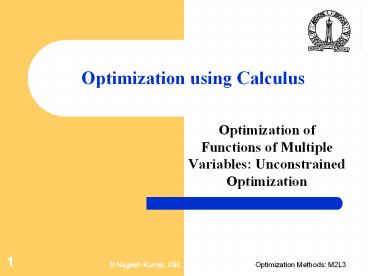Optimization using Calculus PowerPoint PPT Presentation
Title: Optimization using Calculus
1
Optimization using Calculus
- Optimization of Functions of Multiple Variables
Unconstrained Optimization
2
Objectives
- To study functions of multiple variables, which
are more difficult to analyze owing to the
difficulty in graphical representation and
tedious calculations involved in mathematical
analysis for unconstrained optimization. - To study the above with the aid of the gradient
vector and the Hessian matrix. - To discuss the implementation of the technique
through examples
3
Unconstrained optimization
- If a convex function is to be minimized, the
stationary point is the global minimum and
analysis is relatively straightforward as
discussed earlier. - A similar situation exists for maximizing a
concave variable function. - The necessary and sufficient conditions for the
optimization of unconstrained function of several
variables are discussed.
4
Necessary condition
- In case of multivariable functions a necessary
condition for a stationary point of the function
f(X) is that each partial derivative is equal to
zero. In other words, each element of the
gradient vector defined below must be equal to
zero. i.e. the gradient vector of f(X),
at XX, defined as follows, must be equal to
zero
5
Sufficient condition
- For a stationary point X to be an extreme point,
the matrix of second partial derivatives (Hessian
matrix) of f(X) evaluated at X must be - positive definite when X is a point of relative
minimum, and - negative definite when X is a relative maximum
point. - When all eigen values are negative for all
possible values of X, then X is a global
maximum, and when all eigen values are positive
for all possible values of X, then X is a global
minimum. - If some of the eigen values of the Hessian at X
are positive and some negative, or if some are
zero, the stationary point, X, is neither a
local maximum nor a local minimum.
6
Example
- Analyze the function
- and classify the stationary points as maxima,
minima and points of inflection - Solution
7
Example contd.
8
Example contd.
9
Example contd.
10
Thank you
PowerShow.com is a leading presentation sharing website. It has millions of presentations already uploaded and available with 1,000s more being uploaded by its users every day. Whatever your area of interest, here you’ll be able to find and view presentations you’ll love and possibly download. And, best of all, it is completely free and easy to use.
You might even have a presentation you’d like to share with others. If so, just upload it to PowerShow.com. We’ll convert it to an HTML5 slideshow that includes all the media types you’ve already added: audio, video, music, pictures, animations and transition effects. Then you can share it with your target audience as well as PowerShow.com’s millions of monthly visitors. And, again, it’s all free.
About the Developers
PowerShow.com is brought to you by CrystalGraphics, the award-winning developer and market-leading publisher of rich-media enhancement products for presentations. Our product offerings include millions of PowerPoint templates, diagrams, animated 3D characters and more.

